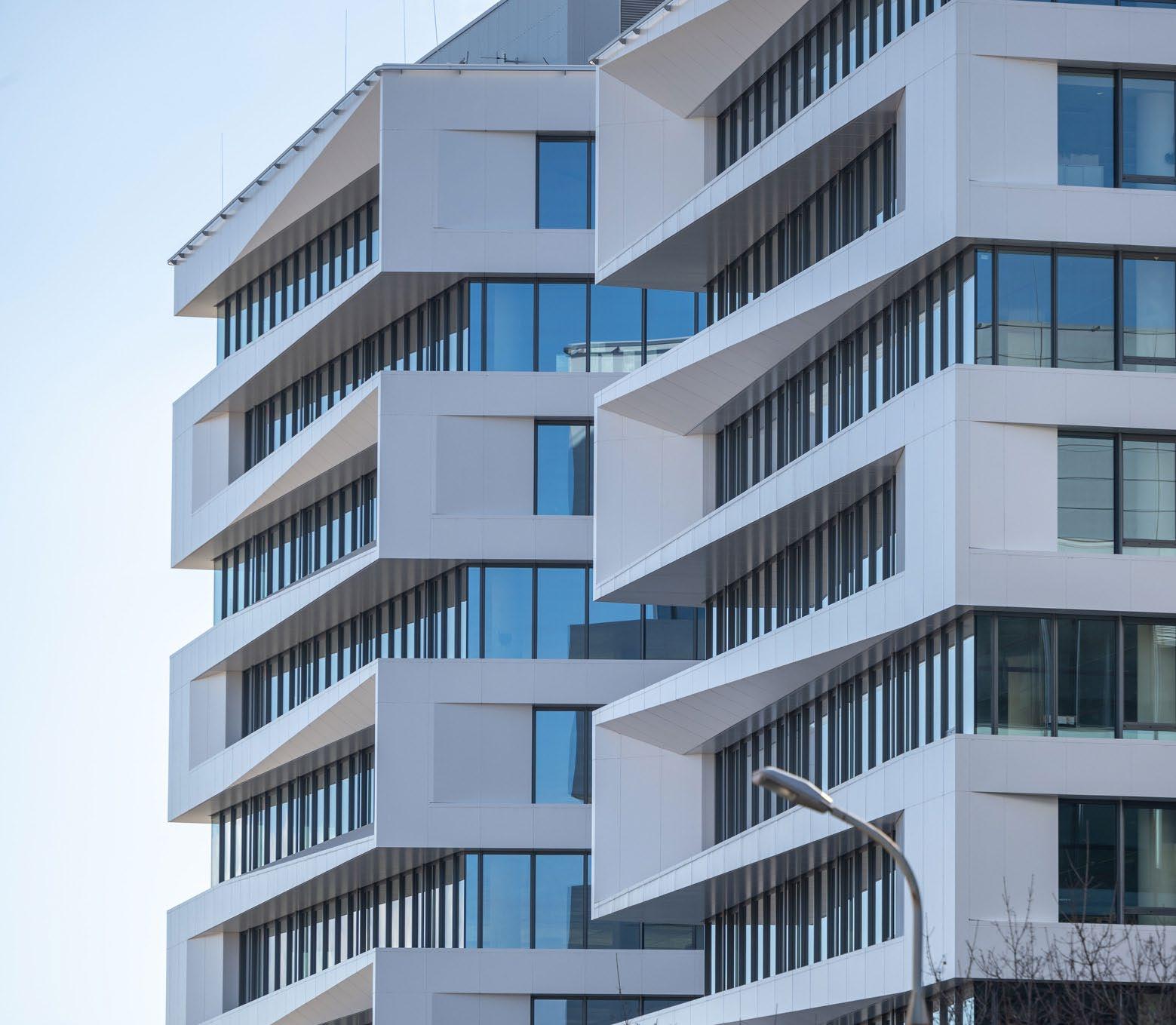Office Market Report

H1 2023






Stock: 12.6% (+2.7 pp yoy)
4,335k sqm (+6% yoy)
Avg. Vacancy: YTD 99,249 sqm (+7% yoy)
Net Take-up: YTD 64,056 sqm
Completion : YTD -6,798 sqm
Net Absorbtion: Avg. Rent 25 EUR/sqm/month (+4.2% yoy)

Prime 19 EUR/sqm/month (+8.6% yoy) cat. „New Built”
16 EUR/sqm/month (+7.5% yoy) cat. „A”
In the first half of 2023, total demand volume and net takeup demonstrated a 4% and 7% rise respectively, when compared to the corresponding period of 2022. This signifies there is still discernible demand, which is undoubtedly encouraging news for landlords. However, these figures remain notably by 19% and 45% respectively lower than the levels observed in H1 2019, before the onset of the Covid pandemic

In H1 2023 newly delivered properties represented a modest pre-lease rate (avg. 37%). Furthermore, less desirable, lower category “B”, less energy efficient properties experienced a surge in vacant stock Consequently, overall market vacancy rate included owner occupied buildings elevated to approximately 12.6% by conclusion of the first half of 2023. Speculative vacancy rate reached 15. 5%, with class “A” office vacancy at 15. 0% and class “B” vacancy at 17% (Figure 1 )
During the first half of the year, net absorption, which was impacted by rising vacancy rates and limited tenant activity, entered negative territory, reaching -6,798 square meters
Prominent transactions in the initial half of 2023 predominantly involved tenants from the BSC (Business Service Center), IT and automotive industry
BSC occupants primarily focused on relocation and optimizing their spatial requirements. In contrast to the preCovid era, there were only a few new market entrants over the past year

While energy prices exhibit signs of stabilization, stock exchange prices continue to substantially surpass levels preceding 2021 However, due to various uncertainties around price fluctuations, tenants persist in seeking energyefficient buildings. This inclination is also mirrored in vacancy rates across different submarkets.
In first half of 2023, the completion of five new speculative office buildings resulted in a total of 64,056 square meters. (Table 1.) This signifies a 41% decrease compared to last years’ corresponding period, which had witnessed the completion of 109,102 square meters. Consequently, total office stock has now exceeded 4 33 million square meters, with speculative stock comprising 3. 53 million square meters of that total.
Total office stock has now exceeded 4.33 million sqm, with speculative stock comprising 3.53 million sqm.
In H1 2023, the total demand volume demonstrated a 4% increase, while net take-up rose by 7%. This signifies there is still discernible demand.


In a year-on-year comparison, a positive trend can be attributed to slight upswing in leasing market activity. In H1 2023 the aggregate leasing activity encompassed 196,556 square meters, reflecting a 4% year-on- year increase Net take-up reached 99,249 square meters, marking 7% increase. Renewal agreements volume exhibited a remarkable 38% surge in comparison to the first half of 2022
The distribution of the deals was different compared with the same period of last year, reflecting a slight growth in net take-up. The breakdown was as follows: pre-leases accounted for a 2 3% share (-4 6 pps year-on -year), new leases constituted a 42. 8% share (+12. 7 pps year-onyear), and expansion deals made up a 5.4% share (-6. 7 percentage points year-on-year) of the total leasing activity (TLA). Renewals represented the largest portion, comprising 47 7% (+11 7 pps year-on-year) of the TLA (Figure 2 )
The heightened activity is underscored by the fact that out of the total TLA, net take-up held a 50. 5% share, which is 1.3 percentage points higher than the figure recorded in the first half of 2022
As in previous years, Váci Corridor submarket sustained its status as the most favoured location in terms of leasing activity, capturing 32% of TLA Central Pest submarket ranks as the second most sought-after location, contributing to 21% of the total leasing activity. However, Central Pest maintains a higher vacancy rate in comparison to average level
In response to the upward trajectory of energy prices, numerous companies have shifted their focus from older office buildings to newer ones in pursuit of more contemporary, environmentally conscious, energy-efficient, and employee- centric environments. This supported by the fact that buildings vacancy rate in class “B” segment is still in higher level (16. 8%) compared to category class “A” offices (15%) We anticipate a more substantial upswing in vacancy rates within the class “B” segment due to the pronounced surge in energy prices, which could place a significant strain on numerous smaller companies. This dynamic serves as an incentive for tenants to transition from class “B” offices to higher-class, more energy-efficient spaces.

Other trend is evident in tenant movements, influenced by factors such as expansion constraints and efficiency considerations. For instance, in city center region tenants are increasingly opting for larger spaces in external locations. For example, there's a notable shift from Central Business District (CBD) to Váci Corridor.
Given the widespread adoption of hybrid working models, several companies continue to downsize or are in the planning phase of reimagining the layout of their leased spaces.
Central Pest submarket ranks as the second most sought-after location, contributing to 21% of the total leasing activity.
Current trajectory of vacancy rate is under the influence of reduced tenant activity in comparison to the period prior to the pandemic, as well as combined impact of the low prelease ratio concerning newly completed properties This has led to a substantial elevation in market vacancy rate, which currently rests at 12. 6%, while speculative market vacancy rate stands at 15.5%.
The extent of speculative vacancy varies across distinct submarkets and categories. (Figure 3-4.) Highest vacancy rates are notably observed in Pest submarkets, particularly in Central and Non-Central Pest, where speculative rate surpasses the average Furthermore, Central Pest has witnessed the most noteworthy annual increase in vacancy (+6.8 pps). Conversely, the lowest rates are found in North and Central Buda (9. 4%, 7. 4%), partly attributed to the presence of modern office stock relative to other regions.
The slightly increased take up also indicates an adjustment and shift towards more contemporary offices and locations. Overall demand for that kind of office spaces is reinforced by the fact that even within class “A” category and buildings are less than 10 years old, vacancy rate remained below average. However, within the latter category, year-on-year rate growth stands as the second highest after Central Pest.
Moreover, the speculative rate of buildings having green certifications reached just 12. 5% by the end of the first half of 2023, which is the third lowest rate after North and Central Buda submarkets.

Since 2014, rents for both class “A” and class “B” office buildings have been experiencing an upward trend. Current average asking rent for all class “A” buildings stands at 16 EUR/sqm/month, while the average of class “B” rents is 12 6 EUR/sqm/month. Anticipated new developments in key submarkets such as Váci Corridor and South Buda are expected to feature headline rents ranging from EUR 17. 0 to 19 0/sqm/month in 2023 While rent levels typically exhibit variations among different submarkets, there is notably greater variance in class “B” market rent levels based on location and the precise technical quality of the building.

Given the market's transition toward being tenant- driven, we anticipate that headline rent for new projects will either stabilize or see modest growth. However, considerably elevated financing and construction costs are exerting pressure on rents to rise Older, less efficient buildings, coupled with soaring energy expenses and increasing vacancy rates overall, will contribute to downward pressure on rent levels. This will lead to a widening disparity in rents between new and existing contracts, as pronounced indexation is not readily evident in new agreements.
In core submarkets like Central Business District (CBD), Váci Corridor, and South Buda, rent levels have experienced more pronounced increases compared to other submarkets. Average asking rent for class “A” office buildings in CBD surpasses 20 EUR/sqm/month and in some prestigious buildings, it can be between 25- 30 EUR/sqm/month (Figure 5 )

Given the market's transition toward being tenant-driven, we anticipate that headline rent for new projects will either stabilize or see modest growth.


Total speculative office pipeline currently in construction and projected until Q4 2024 equates to 186, 114 square meters. Out of this, approximately 62, 028 square meters of office space are expected to be finalized by the end of 2023 (Table 2 ) Roughly 12% of the active speculative pipeline is already pre-leased. For some projects within this speculative pipeline, building permits have been obtained, though the actual construction will only commence upon reaching a satisfactory pre-lease level.
Alongside the surge in financing costs, financial institutions are adopting a more cautious stance, which will also curtail developers' ability to secure funding and initiate the construction phase. Projects that have already initiated construction are anticipated to adhere to their schedules, although minor delays in delivery dates might occur.

Approximately 62,028 square meters of office space are expected to be finalized by the end of 2023.

Speculative office buildings that are currently in the pipeline until Q4 2024 are primarily concentrated in five key submarkets: Non-Central Pest, Central Pest, Central Buda, South Buda and Váci Corridor. (Figure 6.)
Among these submarkets, Central Pest leads with the largest development pipeline, comprising approximately 120,000 square meters of office space. Non-Central Pest follows it with around 44, 900 square meters and Central Buda with approximately 30,000 square meters. These submarkets represent significant areas of growth and development in terms of speculative office projects.

Central Pest leads with the largest development pipeline, comprising approximately 83,000 square meters of office space
Despite the projected slowdown in economic growth for this year, given the evolving demand in the first half, there remains the potential for tenant demand to either stagnate or experience slight growth, particularly for Class "A" office spaces, throughout 2023. Our forecast indicates that the average economic growth rate for this year will be around0. 8% to 0. 5%. Nevertheless, we project a subsequent increase of 3% to 4% in 2024, which could also manifest in improved tenant activity.

Lower EUR/HUF average exchange rate and reduced potential for construction demand in 2023 may contribute to a consolidation in the growth of prices within construction industry. This, in turn, could positively impact the real estate development sector.
In an environment marked by escalating interest rates alongside significantly increased financing costs, there could be delays in the execution of certain projects that are yet to commence. This introduces complexity into forecasting the pipeline.
Practically, these trends could lead to an expansion of class “A” office stock, while a further decrease can be anticipated for class “B”. Relatively lower energy efficiency of class “B” buildings has led to a noticeable surge in service charges, triggering a decline in tenant demand With the mid-term projection not foreseeing energy prices reverting to pre2021 levels, offices operating with limited energy efficiency primarily class “B” might encounter significant setbacks in terms of demand
In recent years, an observable decline in demand, coupled with an increasing number of completed buildings, has resulted in a rise in vacancy rates Considering the ongoing speculative pipeline for 2023- 2024 ( 210,000 sqm) and if demand remains modest, vacancy level is expected to continue its ascent in the coming year. (Figure 7.)
We foresee this modest demand trend persisting over next two years due to space optimization and the overall negative market environment. Prevalent pattern of major international tenants shifting to more modern buildings while optimizing their space utilization is poised to continue as a significant market trend Additionally, the presence of ESG-related certifications (LEED, BREEAM, Well, Access4You) is set to play a pivotal role in tenant’s decision-making, a trend already reflected in the lower than average vacancy rates of certified buildings

We project a subsequent increase in GDP of 3% to 4% in 2024, which could also manifest in improved tenant activity.
Increasing competition among landlords is foreseen in five years ahead. Owners of older properties are likely to invest more in asset management initiatives (such as facelifts, ESG compliance, and energy-efficient upgrades) to enhance the appeal of their offices to potential tenants.
Given the potential long-term repercussions of the pandemic on office space requirements and the prevailing uncertainty in Europe stemming from conflicts and economic instability, tenants are seeking greater flexibility from landlords in lease agreements. This encompasses factors like incentives, lease duration, and space size
In accordance with our expectations, headline rents are projected to remain stagnant or undergo slight increases in the foreseeable future. Due to rising fit-out contributions and longer periods of rent-free occupancy, net effective rent may remain comparable to the previous year. Rent levels for new projects are expected to see further escalation due to heightened construction and financial costs
This


document has been prepared by Colliers for advertising and general information only. Colliers makes no guarantees, representations or warranties of any kind, expressed or implied, regarding the information including, but not limited to, warranties of content, accuracy and reliability Any interested party should undertake their own inquiries as to the accuracy of the information. Colliers excludes unequivocally all inferred or implied terms, conditions and warranties arising out of this document and excludes all liability for loss and damages arising there from This publication is the copyrighted property of Colliers and/or its licensor(s) ©2023
rights reserved Colliers International Group Inc